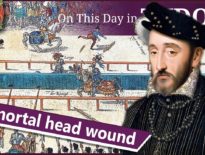On this day in Tudor history, 29th June 1537, just over a year after the execution of his former sweetheart, Anne Boleyn, Henry Algernon Percy, 6th Earl of Northumberland, died at around the age of thirty-five.
He'd been ill for some time and had actually collapsed after he sat in judgement on Anne Boleyn and her brother, George, in May 1536. But who was Henry Percy and what happened between him and Anne?
Find out more about him in today's talk.
Also on this day in Tudor history, 29th June 1509, just four days after she had enjoyed the coronation celebrations of her grandson King Henry VIII and his queen consort, Catherine of Aragon, sixty-six-year-old Lady Margaret Beaufort died. Margaret Beaufort was the matriarch of the Tudor dynasty and was an amazing woman, in many ways, yet she is surrounded by myth and it seems fashionable to see her as a religious zealot. But who was this influential Tudor lady? What did she do? Find out in last year’s video:
Also on this day in history:
- 1536 – Thomas Boleyn, Earl of Wiltshire, was stripped of his office of Lord Privy Seal. Cromwell succeeded him and was formally appointed 2nd July 1536. Wiltshire had held the office since January 1530.
- 1537 – Execution of John Hussey, Baron Hussey and Chief Butler of England, by beheading at Lincoln after he was accused of conspiring with Lord Darcy during the Pilgrimage of Grace.
- 1540 – Bill of attainder passed against Thomas Cromwell for the crimes of corruption, heresy and treason, stripping him of his honours and condemning him to death.
- 1541 – Hanging of Thomas Fiennes, 9th Baron Dacre, at Tyburn. He was hanged after he and his companions murdered a servant of Nicholas Pelham while poaching on Pelham's estate in April 1541. He was buried in the church of St Selpulchre.
- 1552 – Birth of Elizabeth Carew (née Spencer), Lady Hunsdon, literary patron, at Althorp, Northamptonshire. Elizabeth was the sixth child of Sir John Spencer of Wormleighton and Althorp, and his wife, Katherine. Elizabeth was married first to Sir George Carey, 2nd Baron Hunsdon and grandson of Mary Boleyn, and then, after his death, to Ralph Eure, 3rd Baron Eure. Edmund Spenser's “The Faerie Queene” was addressed to “the most vertuous, and beautifull Lady, the Lady Carew” and men such as Thomas Churchyard, Thomas Nashe, Abraham Fleming, Thomas Playfere, Henry Lok and John Dowland also dedicated works to her.
- 1613 – The Globe Theatre burned to the ground after catching fire during a performance of Shakespeare's “Henry VIII”. Sparks from a cannon fired during the play ignited the thatched roof.
Transcript:
On this day in Tudor history, 29th June 1537, Henry Algernon Percy died at around the age of thirty-five. He was buried at Hackney Parish Church, and his will appointed the king as supervisor and Edward Fox, Bishop of Hereford, and Thomas Cromwell as executors.
Henry Percy was born in around 1502 and was the eldest son of Henry Algernon Percy, 5th Earl of Northumberland, and his wife, Katherine Spencer. He was brought up in Cardinal Wolsey’s household and it was while he was there that he fell in love with Anne Boleyn following her return to the English court in late 1521. Anne was serving Queen Catherine of Aragon as one of her ladies and George Cavendish, Wolsey’s gentleman-usher, recorded that when the cardinal and his servants were at court, Percy “would then resort for his pastime unto the queen’s chamber, and there would fall in dalliance among the queen’s ladies, being at the last more conversant with Mistress Anne Boleyn than with any other.” It was then “that there grew such a secret love between them that, at length, they were ensured together, intending to marry.”
Unfortunately for the two lovebirds, they were supposed to be marrying other people. Percy’s father had already planned Percy’s marriage to Mary Talbot, daughter of George Talbot, fourth Earl of Shrewsbury, and Anne was meant to be marrying James Butler, son of Piers Butler of Ireland. Cavendish also states that King Henry VIII was “much offended” at news of the couple’s romance because of his own “secret affection” for Anne. As a consequence, Wolsey and Percy’s father put a stop to the relationship. Percy married Mary Talbot in 1524, but the marriage was far from happy. In 1532, Mary accused her husband of being pre-contracted to Anne Boleyn and Percy was examined by the Dyke of Norfolk and the Archbishops of York and Canterbury. He swore on the blessed sacrament in front of the duke, the archbishops and the king’s canon lawyers that there was no truth to his wife’s story. Percy ended up having to deny the precontract’s existence again in 1536 when Thomas Cromwell was looking for a way to get the marriage of Henry VIII and Anne Boleyn annulled.
Percy served Henry VIII as warden of the east and middle marches, and was one of the peers appointed to judge George and Anne Boleyn at their trial on 15th May 1536. Percy collapsed after Anne’s death sentence was pronounced, and his illness prevented him from taking an active role in the Pilgrimage of Grace rebellion of late 1536, which may have been fortunate, since his brothers, Thomas and Ingram, were arrested for their involvement, and Thomas was executed. Ingram died in prison in the Tower of London.
Antiquary John Weever, in his book Ancient Funerall Monument, mentions the tomb of Henry Percy at Hackney and records that it had the following inscription: “Here lieth interred, Henry lord Percy, earl of Northumberland, knight of the most honourable order of the Garter, who died in this town the last of June 1537, the 29th of HEN VIII.”



Leave a Reply